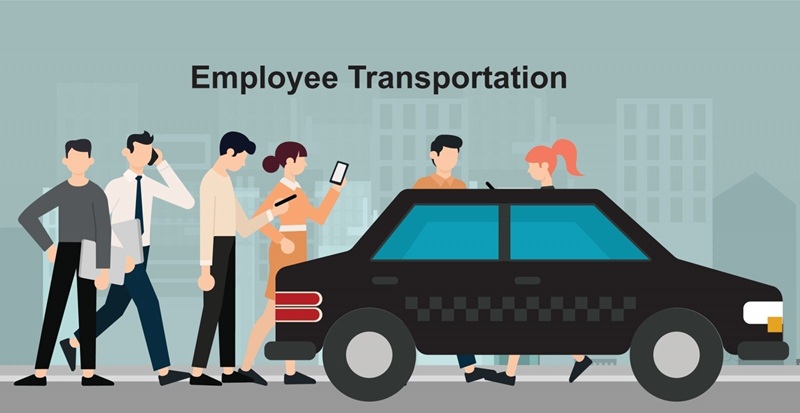
Employee transportation is a critical part of business operations, particularly for organizations with a large number of employees. This involves transporting employees from home to work or business travel, providing smooth mobility and employee satisfaction. Effective transportation services not only enhance operational efficiency but also contribute significantly to talent retention by solving commute-related issues. Nevertheless, over the past few years, organizations have witnessed a steady increase in transportation expenses. These increased costs have been caused mainly by factors like fuel price inflation, urban traffic congestion, and higher demand for safe transportation.
Moreover, compliance with environmental regulations and labor shortages have also increased costs further. It is essential for companies to understand these root causes in order to adopt cost-saving measures and ensure financial viability. By strategically addressing these issues, organizations can manage transportation costs effectively while still offering efficient and reliable commuting services to their employees.
Factors Contributing to Rising Employee Transportation Costs:
1. Fuel Price Inflation:
Among the primary contributing factors to the increasing cost of transportation is the rising cost of fuel. Certain world economic fundamentals such as fluctuation in prices of crude, trade, and market demand underlie the volatility of fuel costs. Disruption in the supply chain due to incidents such as natural disasters or geo-political disputes further induces fuel price volatilities. For businesses operating company-owned shuttle vans or paying employees for miles driven, these unpredicted surges can be a strain on their finances. In addition, the transition to renewable energy sources, while as crucial to long-term viability as it is, has a tendency to create fuel price spikes in the short run as traditional energy sources face policy restrictions. Firms must absorb these costs or pass them on to consumers, fuel price inflation becoming a bane of passing on transport costs efficiently.
2. Urban Traffic Congestion:
Urban traffic jams have emerged as a rising issue in cities around the globe. Urbanization, population increase, and poor infrastructure are the major causes of longer travel times and congested roads. For organizations that use fleet vehicles or ride-sharing, this means higher idle fuel usage and longer travel times. These inefficiencies greatly increase operating costs, as vehicles remain on the road for longer periods and need to be serviced more often. Also, traffic congestion affects productivity indirectly by causing delays and shortening the time available for employees to work. Businesses can also incur fines or extra expenses as a result of missed deadlines or delayed deliveries as a result of traffic-related disruptions. Solving urban congestion needs collective cooperation between businesses and city planners, with an emphasis on upgrading infrastructure and intelligent traffic management solutions.
3. Regulatory Compliance and Environmental Standards:
Governments and regulatory agencies across the globe are adopting tougher environmental regulations that seek to cut greenhouse gas emissions and ensure sustainability. These regulations tend to mandate companies to adhere to emission levels, shift to green fleets, or use environmentally friendly practices. For firms with large transportation requirements, this translates to purchasing electric or hybrid vehicles, retrofitting current fleets to achieve compliance levels, or adopting new technologies to track and minimize emissions.
Though these practices are vital for environmental sustainability in the long run, they tend to have high initial costs. Even their implementation could include elaborate administrative procedures, and therefore, enhance operational costs further. Businesses are compelled to make a balance between being environmentally friendly and being thrifty with transport expenditure, an endeavor that has to be accompanied by strategic planning and allocation of resources.
4. Increased Demand for Safe and Comfortable Travel:
The COVID-19 pandemic has redefined employee expectations about transportation comfort and safety. Workers now value hygiene, physical distancing, and air quality during commuting. To counter this, organizations have been compelled to invest in sanitization processes, regular vehicle cleaning, and the fitment of sophisticated ventilation systems. In addition, to meet health requirements, numerous companies have cut down passenger capacities in shared transport services, necessitating extra trips to transport the same number of employees.
These steps, though necessary to ensure employee safety and confidence, add to the cost of transportation. Additionally, the offer of amenities like comfortable seats, internet accessibility, or in-transit entertainment to further enhance the travel experience adds to costs. Managing employee satisfaction with cost control has become a key challenge for organizations to use this new paradigm.
5. Labor Shortages and Driver Wages:
The industry is encountering a critical deficiency of qualified drivers, provoked by a senior workforce, low driver retention levels, and small interest in becoming a driver amongst the young populations. This has led to excessive competition amongst companies, and for this reason, wages have improved, signing rewards have increased, and extra facilities are offered by employers to induce and keep more drivers. For businesses with their own fleets or partnering with third-party transportation providers, these additional costs of labor affect transportation budgets.
Additionally, driver shortages lead to service outages, making companies resort to expensive stop-gap measures like temporary contract drivers and leasing extra cars. Solving this problem is a long-term solution that entails investments in training programs for drivers, better working conditions, and the use of technology to manage fleets more effectively and minimize dependence on manual efforts.
6. Expansion of Remote Work Benefits:
Although remote work has minimized commuting needs, it has also presented new challenges. Businesses offering transport allowances or relocating employees with hybrid jobs at their own expense might experience extra financial burdens.
Benefits of Using an Employee Transportation Management System
1. Route Optimization:
ETMS uses advanced algorithms to scan transport routes and determine the most optimal routes. Based on traffic flow, road conditions, and distance, these systems reduce travel time and fuel usage. Businesses can steer clear of traffic hotspots, eliminate unnecessary detours, and optimize overall fleet performance.
This not only saves fuel costs but also lowers vehicle wear and tear, thus reducing maintenance costs. Moreover, optimized routes allow for timely delivery for employees, increasing punctuality and productivity. Companies using ETMS for route optimization can significantly save costs while enhancing their operational reliability.
2. Real-Time Tracking and Monitoring:
Real-time GPS tracking offered by ETMS allows organizations to track the location and movement of their vehicles in real time. This facility minimizes idle time, unauthorized use of vehicles, and detours. By monitoring driver behavior, including speed, braking habits, and schedule compliance, companies can take corrective action to improve efficiency and safety.
Real-time monitoring also enables enhanced communication with drivers, allowing prompt reaction to sudden delays or deviations from the planned route. All these features assist organizations in cost savings through optimizing fuel usage and avoiding abuse of resources while continuing to provide high-quality service.
3. Dynamic Scheduling:
Dynamic scheduling is one of the important features of ETMS that enables organizations to modify the transportation schedules according to real-time employee requirements and shifts in work schedules. Dynamic scheduling ensures that vehicles are utilized optimally and not wasted, and the number of trips is minimized. For example, during the off-peak hours or when fewer employees need transport, ETMS can merge the routes to maximize vehicle usage.
Moreover, dynamic scheduling enables firms to adapt to last-minute changes, like the absence of workers or overtime shifts, without excessive cost. Through the alignment of transportation services with demand, companies can achieve maximum utilization of resources and optimal operating costs.
4. Data Analytics for Cost Management:
ETMS offers precise data analytics of different transportation facets, such as fuel usage, route efficiency, vehicle maintenance, and total cost. Such insights allow companies to spot trends and identify inefficiencies in their business. For instance, regular analysis can show high-cost routes or inefficient fuel-guzzling vehicles, allowing corrective measures to be taken in time.
By using data-driven decision-making, organizations can adopt cost-saving strategies, e.g., streamlining fleet composition or renegotiating contracts with vendors. In addition, frequent reporting fosters transparency and accountability, enabling businesses to remain budget-conscious and become financially sustainable in the long run.
5. Enhanced Employee Experience:
Enhanced transport systems provide a more satisfactory overall experience for staff, making them comfortable, secure, and convenient during their commutes. ETMS allows organizations to provide services such as precise pick-up and drop-off times, real-time tracking of vehicles for employees, and communication features to answer questions in a timely manner.
By removing uncertainty and minimizing travel-related stress, these systems increase employee satisfaction and productivity. A pleasant commuting experience also increases morale, lowering absenteeism and turnover rates. In the end, investing in employee-focused transportation solutions not only saves money but also creates a loyal and motivated workforce.
6. Integration with Payroll Systems:
Most ETMS systems can easily interface with payroll software to automate reimbursements and allowances for transportation-related expenses. This minimizes administrative costs by doing away with the need for manual calculations and records. Integration helps ensure accuracy in tracking expenses, reducing errors and discrepancies.
For example, employees are reimbursed in time for their actual trip history, promoting trust and satisfaction. Additionally, automated processes save HR resources to enable them to be engaged in more strategic activities. With streamlined financial transactions, organizations can attain higher efficiency and cost-effectiveness in handling employee transportation costs.
5 Tips to Reduce Employee Transportation Costs:
While implementing an ETMS is a robust solution, there are additional strategies organizations can adopt to further cut transportation costs:
1. Invest in Sustainable Transportation Options:
Switching to electric or hybrid cars for corporate fleets will generate long-term savings on fuel and maintenance. These cars are usually subsidy eligible by the government as well as for tax benefits, so they are a cost-effective solution. And by encouraging cycling or walking for those who live close to work, transport costs are minimized further.
Promoting sustainable behavior is in line with environmental goals and increases the reputation of the organization as a corporate responsible entity. Investments in green transport modes also future-proof companies against changing regulatory requirements.
2. Leverage Technology for Cost Monitoring:
With the use of sophisticated analytics tools to track transportation expenses, organizations can recognize inefficiencies and take corrective actions. These tools monitor important indicators like fuel usage, maintenance costs, and driver behavior, yielding actionable insights.
For example, recognizing excessive fuel consumption patterns can trigger route optimization or vehicle replacement. Real-time monitoring systems also increase accountability and guarantee maximum resource utilization. Through the use of technology, businesses can manage costs proactively and keep their transportation budgets under control.
3. Optimize Employee Work Hours and Shifts:
Scheduling work according to the location of employees and shift needs reduces transportation needs. Clustering employees residing in the same area into synchronized shifts minimizes the need for commuting vehicles. Flexible working hours and telecommuting reduce daily commuting needs.
These practices not only reduce operating expenses but also enhance job satisfaction by accommodating individual tastes and minimizing travel-induced stress. Rationalized scheduling assures optimal utilization of resources and raises overall productivity.
4. Partner with Reliable Vendors:
Working with reputable third-party transportation providers simplifies operations and saves money. Choosing vendors who have competitive pricing and well-maintained fleets guarantees good service and keeps unforeseen expenses to a minimum.
Close relationships with reputable suppliers also yield access to added-value services, including real-time monitoring and routine maintenance inspections. Outsourcing the transportation functions to skilled providers enables organizations to concentrate on their core business functions and attain cost-effectiveness while retaining high-quality services.
5. Route Optimization:
Minimizing fuel usage, minimizing the distance traveled, and minimizing time traveled. It can happen in a variety of ways including technology on a fleet management system which then monitors the travel patterns to identify inefficiencies in routes.Dry runs (or trips in which the cars are not filled to maximum capacity) can waste significant amounts of time and fuel. Route Optimization can cut down on these types of trips by reprogramming the workers that live on similar routes, reconfiguring schedules to ensure (when possible) the vehicle is running at or near capacity.
The increasing expense of employee transport is a challenge that needs a proactive and multi-dimensional solution. By knowing the drivers of such expenses and tapping into solutions such as employee transport management systems, organizations can easily manage costs without compromising on high employee satisfaction. Furthermore, strategies such as carpooling, green transport, and optimized working schedules further maximize cost-effectiveness.
At a time when operating costs are constantly increasing, transportation cost management as a top priority is not only a money-saving imperative but also a measure towards establishing an enduring and worker-focused workplace.


